Red gums in dogs can point to a variety of health issues, from dental disease to life-threatening heat stroke. To help you have a better idea of what to do if you notice your dog has red gums, integrative veterinarian Dr. Julie Buzby explains the nine most common causes of red gums and what they could mean for your dear dog.
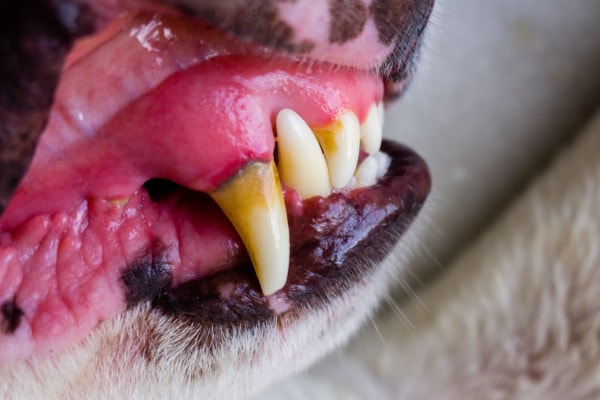
Most pet parents know that bright pink gums are a sign of good health. But what about red gums? Well, as you are about to discover, red gums in dogs can accompany a variety of medical conditions. Some of these conditions are life-threatening, while others are less dangerous. But all are worth recognizing so you can get your dog the help he or she needs.
The best way to recognize a problem is to know what is normal. So let’s take a closer look at a dog’s gums and why they have the color they do.
Canine gums and gum color
When your veterinarian talks about your dog’s gums, he or she is usually referring to the pink tissue that surrounds the base of your dog’s teeth. The gums (i.e. gingiva) cover the alveolar bone which holds your dog’s teeth securely in place. There is a lot of bacteria in a dog’s mouth. So the gums have the important role of helping prevent the alveolar bone from becoming infected or diseased.
For most dog breeds, healthy gums are solidly pink in color. However, certain breeds like Chow Chows and Chinese Shar Peis are prone to black pigmentation on their gums. This pigmentation is not detrimental to their health. But it does make it a little harder to discern normal from abnormal gum color.
Like most soft tissues in pets (and people), pink is the default gum color thanks to blood that flows through the small blood vessels in gum tissue. This is why, in conditions that compromise blood flow or cause anemia in dogs (i.e. low red blood cell numbers), you might see pale pink or white gums. And when the dog isn’t getting enough oxygen, he or she may have purple or blue gums (the color of poorly oxygenated blood).
9 causes of red gums in dogs
And in some situations (which we are about to discuss), the gums may be red. The exact color may vary from bright or cherry red gums to dark or brick red gums. And all the gum tissue might be red, or only certain portions might be red.
Let’s take a closer look at nine potential causes of red gums in dogs.
#1: Heat stroke
Heat stroke in dogs occurs when a dog’s body temperature becomes so elevated that it can permanently damage internal organs. If left untreated, death can occur. Since heat stroke is so serious, I wanted it to be the first cause of red gums in dogs that we discussed.
Heat stroke can happen to any dog, especially on hot days or when left in a hot car. But certain dogs (e.g. brachycephalic breeds like Bulldogs and Pugs, obese or overweight dogs, or those with underlying medical conditions) are at a higher risk of developing heat stroke.
Ideally, you would do your best to keep your dog cool in summer. But it is also important to be able to recognize the signs of heat stroke.
The average pup may have red gums after over-exerting themselves or if your dog is overheating mildly. However, the red gum color should only be temporary. And it should improve once a dog has had time to relax and you take steps to cool down your dog.
Recognizing heat stroke in dogs
But for dogs with heat stroke, their gums remain brick red. They may also have a prolonged capillary refill time (CRT), which is the time it takes for the gums to refill with blood after pressure has been applied. And dogs with heat stroke might show some of the following signs:
- Excessive panting or salivation
- Weakness or collapse
- Vomiting or diarrhea
- Loss of consciousness or acting confused
- Seizures in dogs
If you see dark red gums plus these signs, immediately wet your dog down with cool (not cold) water and turn on the A/C in the car as you drive to the vet for an emergency vet visit. Heat stroke in dogs can be life threatening, so every minute counts.
#2: Periodontal disease
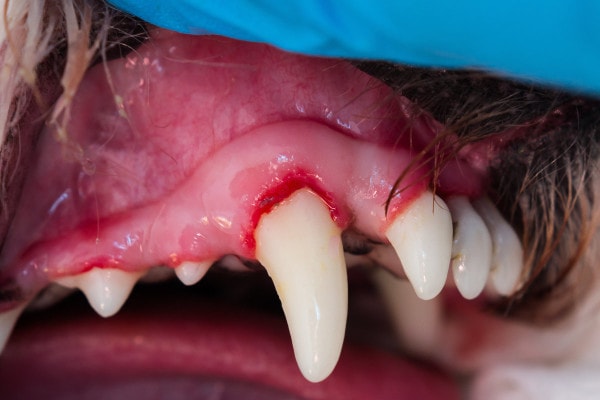
Periodontal disease (i.e. dental disease in dogs) is one of the most common causes of red gums, in part because it is such a common condition in dogs. In fact, over 80% of dogs have some degree of dental disease by the age of three years. And dogs with small mouths (think Chihuahuas and Yorkshire Terriers) and dogs with crowded teeth (like in Shih Tzus and Pugs) are especially prone to periodontal disease.
The term “periodontal disease” refers to inflammation of the periodontium (i.e. the soft tissues structures surrounding the teeth, including the periodontal ligament and the gums). In periodontal disease, the inflammation occurs due a bacterial infection. As part of periodontal disease, dogs may have gingivitis, which is inflammation of the gums. This leads to bright red gums, with the redness centered around the teeth.
There are four stages of periodontal disease in dogs, starting with mild plaque and tartar plus gingivitis at Stage 1. This is the only reversible stage of periodontal disease. As the periodontal disease progresses through Stages 2, 3, and 4, the dog loses more and more of the bone and supporting soft tissues around the teeth. The end result is dental pain and tooth loss.
Recognizing periodontal disease
In addition to having bright red gums around the teeth, dogs with periodontal disease may show the following signs:
- Reluctance to eat hard food or treats
- Bad breath in dogs
- Bloody drool
- Older dog losing teeth
- Swelling below the eye due to a dog tooth abscess
- Signs your dog is in pain (e.g. pawing at the mouth, withdrawing from family, etc.)
- Visible brown, tan, or black debris on the teeth (tartar and plaque)
If you see bright red gums plus these signs, please contact your vet. Your dog most likely needs a teeth cleaning under general anesthesia, and potentially some dog tooth extraction(s) too. Then, after the dental procedure, your vet can discuss brushing your dog’s teeth or other ways to prevent poor oral hygiene from becoming as much of a problem in the future.
#3: Gum tissue injury
Another cause of inflamed red gums is trauma or injury. Many dogs love to chew their toys. But some chew a little too intensely while others chew on things they shouldn’t. Both can result in trauma to the gums, leaving behind a bright red (and sometimes bleeding) area on the gum tissue.
Additionally, sometimes part of a toy or stick can get trapped between the teeth or across the roof of the mouth, especially in large breed dogs. This may cause your dog to suddenly have bad breath, paw at the mouth, or have an area of reddened, inflamed gums. If you see these signs, consider having your veterinarian help you check your dog’s mouth.
#4: Immune-mediated thrombocytopenia (ITP)
Occasionally, dogs may develop a condition called immune-mediated thrombocytopenia (ITP in dogs), where the dog’s immune system attacks his or her platelets. This can lead to low platelets in dogs, which is problematic because the body needs platelets for blood clotting.
Without enough platelets, the dog is prone to spontaneous bleeding and bruising. This may show up as brick red gums with pinpoint bruises (petechiae) or larger bruises (ecchymoses). Plus, the dog may have:
- Bruising on other parts of the body (e.g. the belly or inner ears)
- Dog nose bleeds
- Bloody vomit
- Other signs of bleeding
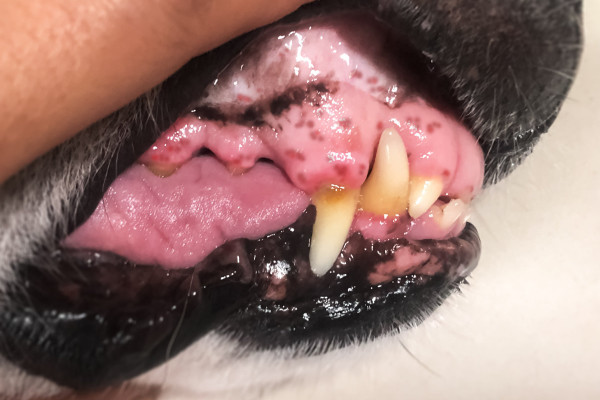
ITP can be dangerous and sometimes even fatal. So if you ever see red gums with red splotches on them, get your dog to the vet ASAP. The sooner you start treatment, the better.
#5: Toxicity
Certain toxins can also cause red gums in dogs. For example, if dogs are exposed to carbon monoxide, they may have a cherry red gum color. Plus, corrosive agents such as concentrated household cleaners may cause distinct red areas on the gums. And dogs who get into anti-coagulant rodenticide (i.e. rat poison) may have red splotches on their gums.
If you think your dog may have gotten into a toxin, immediately contact ASPCA Animal Poison Control Center, Pet Poison Helpline, or your veterinarian for advice, and then do as they say. (There is a fee associated with the toxicology services, but the information they provide is worth every penny.) When it comes to toxins, time is of the essence. So don’t delay in getting help for your dog.
#6: Viral papilloma
Sometimes dogs can develop viral papillomas, which look like small wart-like white growths on the gums, lips, or muzzle. Papillomas are usually caused by the papillomavirus and occur when the virus comes in contact with broken skin.
Occasionally, the dog may accidently traumatize one of the growths by biting it or when chewing on something. This can cause the gums in the area around the growth to be bright red.
Most of the time, a dog only has a few papillomas at a time. But sometimes they do have an excessive number of growths, which can lead to multiple areas of red gums. Thankfully though, viral papillomas of dogs are benign growths that eventually resolve on their own.
#7: Mouth cancer
On the other hand, dogs can also develop mouth cancer. The cancerous growths tend to enlarge quickly and are locally aggressive. Aside from seeing an area of red and/or bleeding gums, you may notice a large, irregularly shaped mass on the gums or coming from the roof of the mouth. Eventually, larger masses can affect tooth alignment or even the shape of a dog’s face.
Unlike viral papillomas, oral tumors don’t resolve by neglecting them. Therefore, anytime you notice a mass in your dog’s mouth, it is best to consult with the veterinarian promptly. Oral cancers often require therapies such as intensive surgery, radiation, or sometimes immunotherapy (e.g. melanoma vaccine for dogs).
#8: Gingival hyperplasia
Another process in the mouth that can change gum color and appearance is gingival hyperplasia. Essentially this is an abnormal overgrowth of excess gum tissue due an increase in the number of cells present in the gums. While the underlying cause is poorly understood, genetics and certain medications may play a role. Boxers and Bulldogs are the most commonly affected breeds. And medications like cyclosporine can cause gingival hyperplasia.
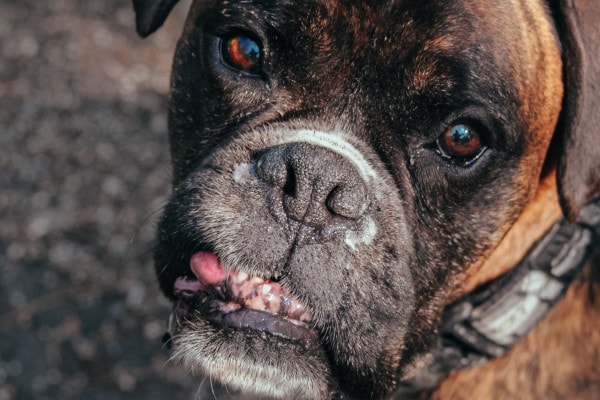
Initially, gingival hyperplasia can start out as overgrown gums with a bubble gum pink appearance. But because the gingival hyperplasia creates a deep pocket around the tooth where bacteria and debris can get trapped, these dogs are very prone to periodontal disease too. Therefore, in dogs with gingival hyperplasia that has been there for a bit, it is common to see red swollen gums due to inflammation from dental disease.
Should you suspect your dog has gingival hyperplasia, it is best to make an appointment with your vet before it starts causing problems. If a medication is to blame, stopping the medication often restores the gum tissue back to normal. Otherwise, there are some procedures that a vet or veterinary dentist can perform to remove the excess gum tissue and improve oral health.
#9: High blood pressure
Dogs with high blood pressure (i.e. hypertension in dogs) may have bright red gums. This occurs because when blood pressure rises, so too does the flow of red blood cells through capillaries, making the tissue appear more red (instead of the normal pink).
Dogs can have hypertension and bright red gums for any of the following reasons:
If you suspect that your dog’s red gums could be due to high blood pressure, please contact your vet promptly. Left untreated, hypertension can have negative effects on the brain, eyes, kidneys, and heart.
Hypotension and sepsis
Also, I want to mention that occasionally a dog can have low blood pressure (i.e. hypotension) and still have red gums. (Normally dogs with low blood pressure should have pale gums due to poor circulation.)
This combination of low blood pressure and red gums tends to occur in sepsis. This is a condition where the body has an abnormal and overwhelming response to an infection, which causes significant and potentially life-threatening damage to the organs. Essentially, the body attempts to fight the infection but creates too much inflammation, which harms the innocent bystanders (i.e. the organs).
You can’t necessarily recognize sepsis just by looking at your dog since it can have a variety of causes and the symptoms may be vague. So if your dog has red gums and has been acting sick or otherwise seems abnormal, heading to the vet is often the safest course of action.
Check your dog’s gum color regularly
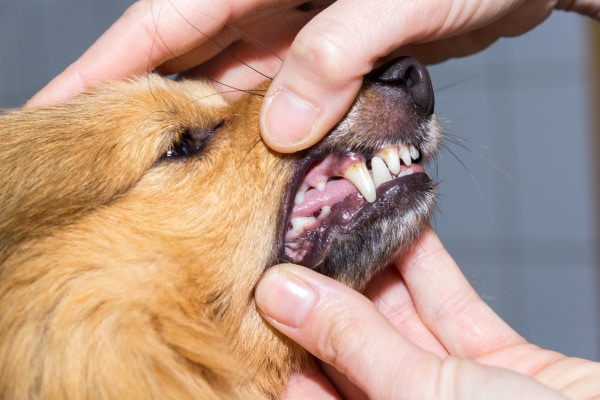
Now that we have discussed nine common causes of red gums in dogs, I’d like to offer my advice. As a proactive dog parent, one of the most important things you can do is regularly examine your dog from head to toe, including checking the color of your dog’s gums.
By making a 5-minutes dog wellness scan part of your weekly routine, you can easily catch problems while they are still small. And being used to looking at your dog’s gums (and the rest of him or her) will make it easier to recognize abnormalities such as red gums in an emergency situation.
(If you want more in-depth information and some videos about how to perform this dog wellness scan, check out my master class: The Tip-to-Tail Health Scan™.)
Contact your vet if you notice red gums in dogs
If you think your dog’s gums might be redder than normal, the best thing you can do is contact your veterinarian (or head to the ER if you suspect your dog may have heat stroke or another life-threatening condition). That way the vet can examine your dog, determine the cause of the red gums, and then create a plan to get your dog feeling better again soon.
What was the cause of your dog’s red gums?
Please comment below.


My 2 year old standard schnauzer has very white teeth except in the very back. However, all of his gums are very red and inflamed. I’m very concerned. We use dental chews daily, put the dental solution in his water and brush occasionally. I’m very worried. Will getting his teeth cleaned help? Is there anything else we can do?
Hi Judie,
I understand your concern for your young dog. If the cause of the inflammation is due to tartar sitting below the gumline then a dental cleaning could be very helpful. The most important thing is to find the underlying cause. Once you have a diagnosis then you can begin to work through the treatment options. I would talk to your vet about scheduling an appointment for a thorough oral exam and evaluation. Hoping for clear answers and an easy solution. You are doing a great job with routine dental care at home! Keep up the good work!
My 14 year old Labradoodle had a bad tooth removed last may. The vet removed a tumor next to the tooth, but thought it was a benign growth as a result of the tooth. In late Oct we took her in for a routine checkup and the tumor was back. In November they checked it again and it was growing fast and at that time the vet suspected oral cancer, so in December he removed it removed it taking it all of the way back to the bone and sent it for biopsy. The resul of cancer came back just after Chrismas. it was cancer, but they needed to do additional testing to determine the type. Starting on Jan 6th, we were at the vet every other day. The tumor would start bleeding and not stop for hours. She has a reaction to the sedative, and couldn’t move for almost a day. She got severe diarrhea, that also bled. On Friday Jan 16th we finally got the full diagnosis of osteosarcoma. At that poin, except for the doggie diaper was almost normal. On Monday, we took her for her first Oncologist appt. They gave us a very poor prognosis and suggested palliative care. she had a great almost puppy-like day on Tuesday. On Wed morning she couldn’t stand and had labored breathing. We already had a follow-up appt that afternoon with her regular vet to discuss pain mgt, so we took her in. She could hardly move, and the breathing was very labored. Upon examination, she cherry red gums. The vet was surprised by that. He expected them to be white. I didn’t ask why, but asked what should we do. And he said none of it was good. My wife and I had already agreed on the drive over that it might be time, and so we said goodbye. I sometimes wonder about the red gum thing. I assumed she had an infection with the bleeding in the mouth and diarrhea, but she may have reacted to the new pain med. I’m not sure. Do you know why her gums would have been dark red given those circumstances?
Dear Joe,
I am sorry for the loss of your senior girl to this terrible cancer. I too would have been concerned with her bright red gums but also have no idea why they would have been this way. I think you made a loving choice to give your sweet girl a peaceful passing and spare her from unnecessary suffering. Wishing you peace and comfort for the days ahead. Bless you and your family.
My dog vomited and when I checked her over I saw that her gums were bright red. The emergency vet was in surgery so I took her to a vet open on Sunday. He indicated she was very sick, do d X-rays and blood and said to get her to vet first thing in morning. Didn’t see anything on the tests. I took her home and she collapsed. Got her to emergency vet and they said they didn’t think she would make it through the night. She died at 3am. No cause of death. Just an indication of maybe cancer or sepsis. This happened so quickly. She seemed a little quieter than usual, but that was her nature. She started having explosive diarrhea at the vet, which made things worse. She had no diarrhea that morning or the day before. I can’t get over that I didn’t recognize something was very wrong. Shexwas only 9, a smallish dog. . Still feel guilt. It’s been a few months. Thanks .
Dear Nancy,
I am so sorry for the tragic loss of your pup. I can only imagine how hard it must be to still have more questions than answers. Please don’t let guilt play a role in this. There may not have been any other symptoms or signs prior to when she vomited and had red gums. Often conditions like this appear without warning. You acted quickly and sought out medical attention as soon as you realized there was an issue. I am certain your girl knew how much you loved her and that your presence was a comfort. May her memory live on and continue to be a blessing in your life. Wishing you peace and brighter days ahead.
My dog’s gums are red right after eating dinner. In the morning they are pink and look fine. He has crowns (he broke a tooth) so he gets his teeth cleaned under anesthesia yearly and I use tooth wipes to brush his teeth daily. I can’t figure out why his gums look different after eating. He is on a raw food diet, so there’s nothing hard or scratchy. The only thing I can think of is perhaps the enzyme powder that I put on his food is irritating?
Hi Christie,
How strange! This has me puzzled too. The only thing I can think of is maybe the process of eating and producing saliva causes increased blood flow to the gums making them look darker in color? It may be a good idea to take a picture to show your vet. As long as you aren’t seeing any other symptoms, I wouldn’t think this was cause for concern. Thanks for sharing! Best wishes to you and your pup.
My small, male dog has red gums on one side of his mouth. I have been giving him supplemental Vit C as recommended by a DVM. If it doesn’t improve within a week or so, I will take him in to be examined. This article explains why I favor the use of Vit C. It might be useful other people or DVM’s.
https://www.whole-dog-journal.com/food/benefits-of-vitamin-c-to-your-dog/
How Vitamin C Affects Dogs
Wendell O. Belfield, DVM, is perhaps the world’s best-known and most ardent advocate of vitamin C supplementation for dogs. In his book, “How to Have a Healthier Dog,” Belfield describes how he first came to experiment with (and appreciate) the power of vitamin C in his veterinary practice.
Following a particularly heartbreaking episode, where he was unable to save the life of a beloved family dog that had distemper, he began researching viral diseases. In the course of his studies, he came across an article about a doctor who used massive doses of vitamin C to successfully treat viral diseases such as polio and hepatitis in the 1940s. Belfield began wondering whether C could be used to combat canine viral diseases.
One day in 1965, another client came to Belfield’s office with a dog that was suffering from distemper. Belfield decided to try an injection of vitamin C on the dog, and it responded dramatically, surviving what he had been taught in veterinary school was a fatal disease for which there is no successful treatments.
Following this success, Belfield began experimenting with vitamin C treatments for all kinds of conditions in dogs. His trials and studies have convinced him of the tremendous power that the vitamin holds for dogs.”
Hi Lee,
Thank you for offering up this bit of information. Hoping you will start to see an improvement in your pup. Wishing you both all the best!
My dog’s teeth were cleaned after his gums were red. After a very short time his gums are red again.
Hi Karen,
I understand how frustrating it can be to see gingivitis form again so quickly after a dental cleaning. The best thing is prevention. If you haven’t found a good daily dental care routine for your pup, I encourage you to talk to your vet about options. Besides brushing there are also many different ways to prevent plaque, tartar and bacteria from causing dental disease (dental chews, tooth wipes, mouth rinse/spray, water additive, etc.). Find what works best for you and your dog and is easy to work into your daily routine. Best wishes!
Thankyou for this information.. my dogs gums always remain red.. I was taking that normal but now i will consult a veterinary today.. Thanks for this information,..
Hi Priyanshu,
That sounds like a very good idea. Hoping for a clear path forward and a positive outcome!